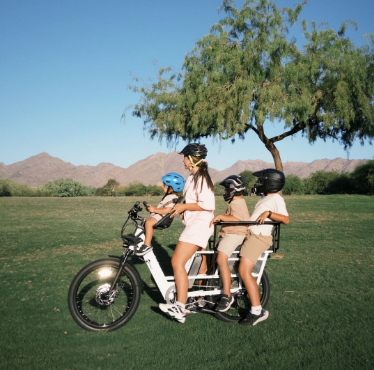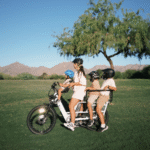Plan your load, lower your speed, brake earlier, and check your tire pressure before every ride. Keep weight low and centered, use two strong cargo straps, and practice slow-speed turns in a safe lot. Most batteries on an Electric Cargo Bike take about 4–6 hours to fully charge with a typical 2–3A charger; we’ll explain how charge rate affects range and safety below.
Quick Safety Checklist for Your cargo E-Bike
Put the essentials up front so you never forget them:
- Pre-ride ABCs: Air (tire pressure set for load), Brakes (no rub, firm lever), Chain/Drivetrain (clean, lubed).
- Lights & visibility: High-lumen front light, flashing rear, and reflective side accents.
- Helmet + gloves: A MIPS helmet and full-finger gloves reduce injury risk and improve grip.
- Speed rule: Loaded means longer stopping distance—cap cruising to 15–18 mph in town.
- Test roll: Ride 100 feet, weave, and brake. If handling feels twitchy, redistribute cargo.
When your Electric Cargo Bike is fully packed, these basics buy you safety margin.
Load, Balance, and Securement
Heavy cargo changes physics. Keep the center of gravity low and centered between the wheels. Place dense items in the rear lower panniers or rear deck boxes, splitting weight left/right; lighter, bulky stuff can go in front bins. Avoid high rear stacks that act like a sail.
Use two points of restraint: a solid ratchet strap plus a backup strap or cargo net. Tug each strap, then push the bike side to side to confirm nothing shifts.
For child seats or live cargo (groceries in soft bags count!), recheck tightness after the first mile. Cornering? Look through the turn, counter-lean your body slightly inside, and keep inputs smooth.
Whether you roll a longtail or front-loader Electric Cargo Bike, master the
mount-and-dismount with cargo before traffic. The predictable torque of a mid drive cargo e-bike helps you start smoothly without lurching, which keeps kids and bags stable.
Braking, Speed, and Stopping Distance
Mass is momentum. With 40–120 lb of payload, braking distance can nearly double if you ride like you’re empty. Use both brakes together, start feathering earlier, and keep your fingers ready—especially on downhills. If your rotors squeal or fade, step up to larger rotors (e.g., 180–203 mm) and inspect pads more often.
On sketchy surfaces, brake before the corner and coast through. In rain, tap brakes lightly to wipe rotors before hard stops.
Downhill technique: use the front brake progressively for most stopping power while modulating the rear to maintain stability—no grabs, just smooth squeeze.
A well-loaded Electric Cargo Bike handled with patience is safer than an empty bike ridden hot. Riders on a mid drive cargo e-bike can downshift early to keep cadence steady and let motor braking help regulate speed.
Power, Gears, and Battery Charging Basics
How long to charge? Roughly 4–6 hours for a common 48V, 14–20Ah pack with a 2–3A charger. Faster chargers cut time but generate more heat; stick to the manufacturer’s spec. For range under load, expect 15–25% less than your empty-bike baseline because of weight and drag.
Use lower gears and pedal at a comfortable 70–90 rpm when starting and climbing. This keeps controller temps down and reduces chain wear. If you feel the motor bog, downshift before adding assist.
Charging safety: let the battery cool 15–30 minutes after a hard ride before charging; place the charger on a nonflammable surface; unplug after full. Store the pack around 50–70% if you won’t ride for a week.
Treat your Electric Cargo Bike like a small delivery vehicle: predictable cadence, smart gearing, and battery care. A mid drive cargo e-bike rewards this with efficient, natural power on hills and smoother low-speed control in traffic.
Route Choice and Traffic Tactics for an Electric Cargo Bike
Pick low-stress routes even if they add five minutes: bike boulevards, protected lanes, and paths with fewer stops. Plan turns to avoid left-across traffic—two-stage lefts are safer and calmer with kids or groceries aboard.
Signal early and claim your lane when needed to prevent close passes; you’re long and slower to accelerate. Build a buffer at intersections by stopping back from the line so cross-traffic can see you.
Wind matters more with cargo; in strong crosswinds, drop speed 3–5 mph and keep elbows loose so the bike can “breathe.”
These small choices keep a loaded Electric Cargo Bike composed in city chaos. If you’re climbing or stopping often, a mid drive cargo e-bike shines because it multiplies your gears and preserves momentum.
Maintenance, Gear, and Weather Readiness
Payload accelerates wear—schedule maintenance by miles and load, not just months.
- Tires: Choose e-rated casings at proper load index; check pressure before every ride.
- Wheels: Re-true and check spoke tension every 300–500 miles under cargo use.
- Drivetrain: Clean weekly if you haul daily; consider e-bike-rated chains and cassettes.
- Hardware audit: Rack bolts, child-seat mounts, kickstand plates—torque them monthly.
- Wet rides: Fenders keep vision clear; waterproof panniers protect batteries, chargers, and laptops.
Good gear removes friction: a dual-leg kickstand, mirror, bell, and a quality frame lock + U-lock combo. With this setup, your Electric Cargo Bike becomes the easy choice every day. Owners of a mid drive cargo e-bike will notice smoother starts that are kinder to chains and knees alike.
Pro Tips as You Advance
- Practice emergency stops in an empty lot with a progressive squeeze.
- Cargo rehearsal: Load the bike for a “dry run” and ride a quiet loop before school or store runs.
- Weight math: Keep total system weight (rider + cargo + bike) within the manufacturer’s rating—never guess.
- Communication: Make eye contact, wave, and be predictably courteous; it buys you space.
- Seasonal check: Cold cuts range; wet roads cut traction—adjust speed and distance accordingly.
Conclusion
Safety with a fully loaded setup isn’t complicated—it’s disciplined routine. Keep weight low and balanced, cap your speed, brake early, and maintain your machine like a pro. Charge smart (plan on 4–6 hours for most packs), and choose routes that trade a minute or two for calmer riding. Follow this template and your Electric Cargo Bike becomes the most dependable vehicle you own. With the precise control of a mid drive cargo e-bike, you’ll handle hills, kids, and groceries with confidence—ride after ride.







